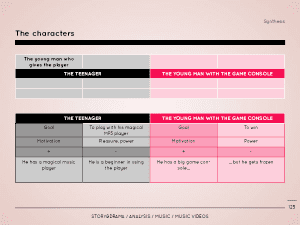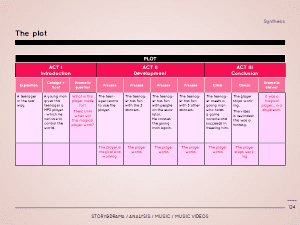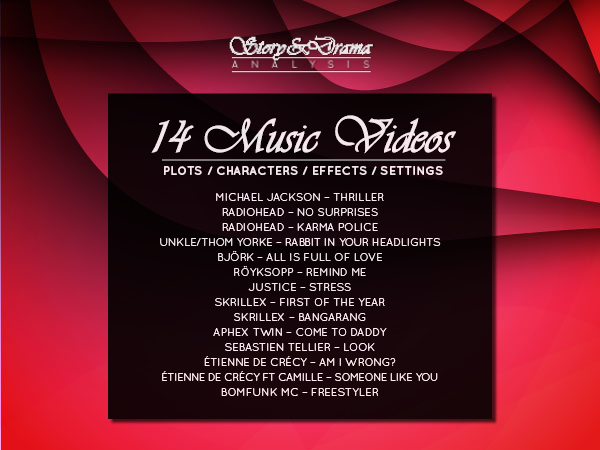This Freestyler – Bomfunk MC music video analysis is an abstract from our tutorial e-book 14 music videos.
Freestyler – Bomfunk MC – Music video script analysis
00:00 In the subway, a guy in streetwear clothes seems to be dancing while the music intro starts playing in the soundtrack. The subway is very white/grey: white floor, light grey stairway, light grey walls, white train, white panels. All of the video will stay in light, clear, whitened colors. This technological, minimalistic, very clean subway, looks great.
World and structure: exposition of the plot to follow. Firstly, the space – urban and daily, then the style of the population living there – this streetwear-dressed guy, and lastly, the style of music that is listened to there.
00:10 The camera begins a panning movement to the left which reveals two young and pretty women – in light-coloured clothing – then a Caucasian teenager with dreadlocks and big earphones on his head. The man, who wears a thick jacket, dances like crazy in front of the perfectly indifferent teenager. The train arrives and the teenager gets on, passing by the man without showing any emotion. The man in the jacket watches him, looking surprised. In the soundtrack the lyrics start (“Freestyler!”) on some punchy electro; a well-rhythmed rap flow and very dynamic, like the pictures.
Structure, characters and characterization: the exposition continues, enrichening the characters’ surrounding population with these two young women, who will hereafter hold a small role, and with this crazy dancer who helps in introducing the video‘s main theme – freedom through music – and seducing the viewer (who we can easily imagine is as young as the characters). The teenager will soon become the Hero of the plot and his emotional indifference already appears as his fundamental thematic property. Jaded, he watches the world around him as if it was a show.
00:49 The teenager walks down through the train, sketching a few dance moves in sync with the soundtrack, then finds a seat in front of a young man who stares at him. The teenager sings with the dubbed voice from the soundtrack.
01:06 The young man across from him seems to invite the teenager to have a look at something. The teenager looks at his hand at a small object which starts to vibrate. The teenager seeks to understand what is happening. He looks around him. Suddenly, the young man who was opposite him is leaving the train, which we see from the platform is starting to drive off again.
Structure and characters: this little scene contains the catalyst and the man who activated the small object (an MP3 player) suddenly takes on an actantial role as Mentor: the one who gives a mission, a goal to the Hero and a way to reach this goal. We can remark that this structure refers directly to the fairytale genre, in which a king or a magician gives a young Hero (often a prince) a magical object to help him in his quest.
01:19 Back to the train. The teenager choses a title on his MP3 reader: Bomfunk. A man with lots of hair sits in front of the teenager who is now activating a FREEZE function on his MP3 player which then freezes this neighbour opposite him. The teenager then activates FWD and the neighbour moves in fast-forwarded images. The teenager confirms that his remote control MP3 player is actually working by speeding up and rewinding his neighbour. Out on the platform, he makes the train quickly go forward and backwards, like in a film.
Structure: this magical MP3 player makes us enter Act II. The goal simply seems to consist of using the remote control to play the world as if it was recorded and viewable on-demand.
01:37 The teenager walks and dances, singing in sync, headphones on his head. He passes in front of three young and pretty women in white and red clothes, standing in the position of frozen dancing. With one strike of the magical player, he makes them move and they dance and sing, one after the other: playback, quick and sexy choregraphy. The teenager freezes them one by one.
Structure: simple adventure of Act II. The three young women do not have any real actantial role and are just a kind of toy projecting the teenager’s fantasies.
01:57 The young man who gave the MP3 player to the teenager is in a nearby phone booth talking with someone.
Characters: the Mentor seems to watch the Hero from afar.
01:59 Dancers do a performance in a hip-hop style. They are moved forward and backwards, manipulated and frozen by the teenager.
02:33 The teenager rewinds a young man on a long escalator. He lets him idle forward and backwards for a while in various positions, then lets him go as he passively goes by the escalator while the previous young man passes in the opposite direction, watching him very frankly when passing by, without the teenager noticing it.
02:59 The teenager leaves the subway. A new young woman, dressed in dark grey streetwear clothes, headphones on her head, is dancing. Actually, there are three, all with headphones on their heads. The teenager freezes then unfreezes them as they dance.
Structure and characters: Act II continues and all these characters we encountered remain passive toys of the Hero‘s whims and thus they take no actantial role.
03:24 The teenager walks, singing in sync. Passersby watch them. The young man we already met two times is there again, sitting calmly.
Characters and repetition: this new Mentor appearance holds something a bit disturbing for the Hero, as if the Mentor did not really trust him. The Mentor thus slightly takes the shape of an Antagonist, we wonder about whether he will suddenly change his mind and take back the magical object which makes the Hero powerful and exceptional.
03:46 The teenager crosses a concrete bridge between two buildings and meets a young man with tinted glasses and a sporty white outfit. This young man stares at the teenager and seems to challenge him. When they pass each other, there is a short shot between the teenager’s hand and the young man’s hand which is holding a gaming console. A few meters after passing by the teenager, this new character turns himself back to the teenager and seems to challenge him with a dance, then he leaves, lifting his arm up in sign of victory. The teenager freezes him in this position.
Structure: this scene of confrontation strongly looks like an Act III crisis, though the conflict is not very clear. In any case, the Antagonist, this young man in the white outfit (does he represent a Hero of a superior rank, a Gaming Master?), is only defeated in extremis, which shows danger is growing for the Hero.
04:10 The teenager slides easily onto an escalator handrail and meets a DJ and hip-hop dancers at the end. He sends them MP3 player signals, but it does not work any more. He tries many times, in sync with the music. The mysterious young man from earlier gets closer to him. The teenager sends him MP3 player signals also but without effect.
Structure: climax. The Hero has lost his magic, leading us to give a negative answer to the dramatic question of the catalyst which we can now redefine more clearly than in the beginning: how much time will the magic work? How much time will the Hero have power over everybody? Answer: just a few minutes.
Characters: the fact that the Hero tries in vain to use the magical object AGAINST the Mentor who gave it to him confirms that this Mentor also had a latent role of Antagonist, though with no obvious conflict.
04:31 The music makes a break and the entire video gets fastly rewinded until the initial moment when the teenager was sitting peacefully, waiting for his train, listening to some music. The music disappears in a decrescendo.
Structure: this final rewind attributes the magic of controlling the world not to the Hero, but to the authors of the video and to the band who signs it – a little meta-fictional pirouette (meta-fictional means that an element of fiction pretends to cross its limits and to become reality). We thus understand that all the plot was a daydream, a fantasy of power from a teenager who is listening to some good punchy music, Bomfunk MC’s of course!
04:53 End


Comment
A modern fairytale
Freestyler gives the example of an apparently very contemporary video but it actually lays on a very old narrative tradition; the European folk tales studied by one of the founders of our modern science of stories (narratology), the Russian, Vladimir Propp.
(Narratology = study of narration. For a brief review of this science, see our e-book Storytelling 2.)
This video’s story stages:
- a young Hero
- meets a Mentor
- who gives him a magical object
- with which the Hero accomplishes a mission
- and fights an Antagonist
- before coming back to the normal world
The only difference in this very classical narrative pattern is the frustrating, disappointing side to the end which derealizes the plot we saw, depriving the Hero of any exceptional force and bringing the viewer, by identification, back to the ordinary reality of time passing by without anybody being able to control its flow.
The tightly connected conformism and anti-conformism work perfectly together to generate the message and touch the young audience. In essence, the video says:
- You, teenager, would like to be as powerful as this Hero
- You have to prove yourself, to control the world around you
- But be careful, because all of this is only fantasy
- You belong to reality, and you need to grow up and to abandon your illusions…
We thus meet again the classical pedagogical function of narration: to share some existential knowledge, a message usable in our real life, without passing by any abstract or boring theory. By seducing us with very cool characters and very nice places, by pretending to play the game of daydreaming and by putting us into the skin and head of the target-audience, this video lectures the youth in a way it would not have tolerated if this same morals had been put in the mouth of a parent or of an educator.
…
Did you enjoy reading the beginning of this music video analysis? Do you want to read more?
Do you want to learn to write a music video script?
Then read our e-book: 14 Music Videos.
